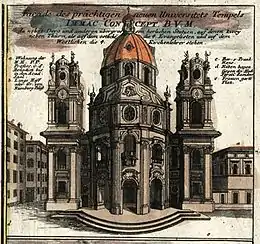Mass in D minor, K. 65
The Missa brevis in D minor, K. 65/61a, is a mass composed by Wolfgang Amadeus Mozart (12 years old at the time) and completed on 14 January 1769.[1] It is scored for SATB soloists and choir, violin I and II, 3 trombones colla parte, and basso continuo.
| Missa brevis in D minor | |
|---|---|
| Mass by W. A. Mozart | |
 Kollegienkirche, the University Church of Salzburg, c. 1712 | |
| Key | D minor |
| Catalogue | K. 65/61a |
| Occasion | Forty-hour vigil held at the Kollegienkirche |
| Composed | 1769: Salzburg |
| Movements | 6 |
| Vocal | SATB choir and soloists |
| Instrumental |
|
It is thought that this mass was performed in the University of Salzburg's Kollegienkirche to open a forty-hour vigil.[2][3] As a Lenten mass, it is likely that the Gloria could not have been performed on this occasion, and would have been composed for subsequent use.[4] This is Mozart's shortest setting of the Order of Mass, and his only missa brevis set in a minor key.[3]
The mass is divided into six movements.
- Kyrie Adagio, D minor, common time
- "Kyrie eleison" – Allegro, D minor, 3/4
- Gloria Allegro moderato, D minor, common time
- Credo Allegro moderato, D minor, 3/4
- "Et incarnatus est" Adagio, D minor, cut common time
- "Et resurrexit" Allegro moderato, D minor, 3/4
- "Et vitam venturi saeculi" Più mosso, D minor, cut common time
- Sanctus Adagio, D minor, cut common time
- "Pleni sunt coeli et terra" Allegro, D minor, common time
- "Hosanna in excelsis" Allegro, D minor, 3/4
- Benedictus Andante, G minor, common time; soprano/alto duet
- "Hosanna in excelsis" Allegro, D minor, 3/4
- Agnus Dei Andante, D minor, common time
- "Dona nobis pacem" Vivace, D minor, 3/8
References
- Deutsch, Otto Erich (1966). Mozart: A Documentary Biography. Stanford University Press. p. 86.
- Sadie, Stanley (2006). Mozart: The Early Years 1756–1781. p. 163.
- Eisen, Cliff; Keefe, Simon, eds. (2006). The Cambridge Mozart Encyclopedia. p. 273.
- Einstein, Alfred (1945). Mozart: His Character, His Work. p. 326.
External links
- Missa brevis in d K. 65 (61a): Score in the Neue Mozart-Ausgabe
- Free scores of Missa brevis in D minor, KV 65 in the Choral Public Domain Library (ChoralWiki)
- Missa brevis in D minor, K.65/61a: Scores at the International Music Score Library Project
- "Missa Brevis in D minor KV 65 (Mozart)". YouTube. 3 April 2015.
- "Missa Brevis in D minor KV 65 (Mozart)". YouTube. 17 July 2013.
This article is issued from Wikipedia. The text is licensed under Creative Commons - Attribution - Sharealike. Additional terms may apply for the media files.